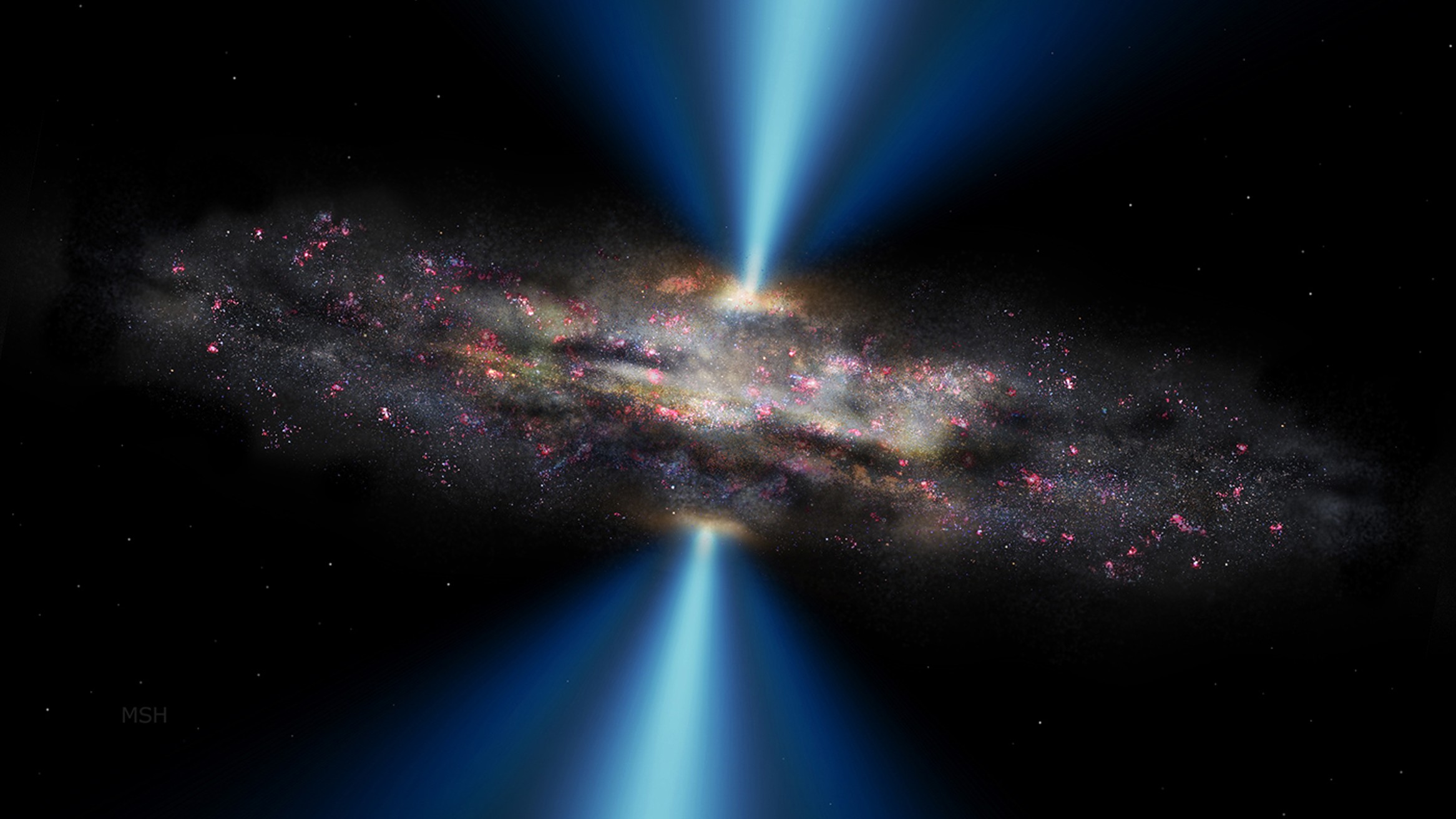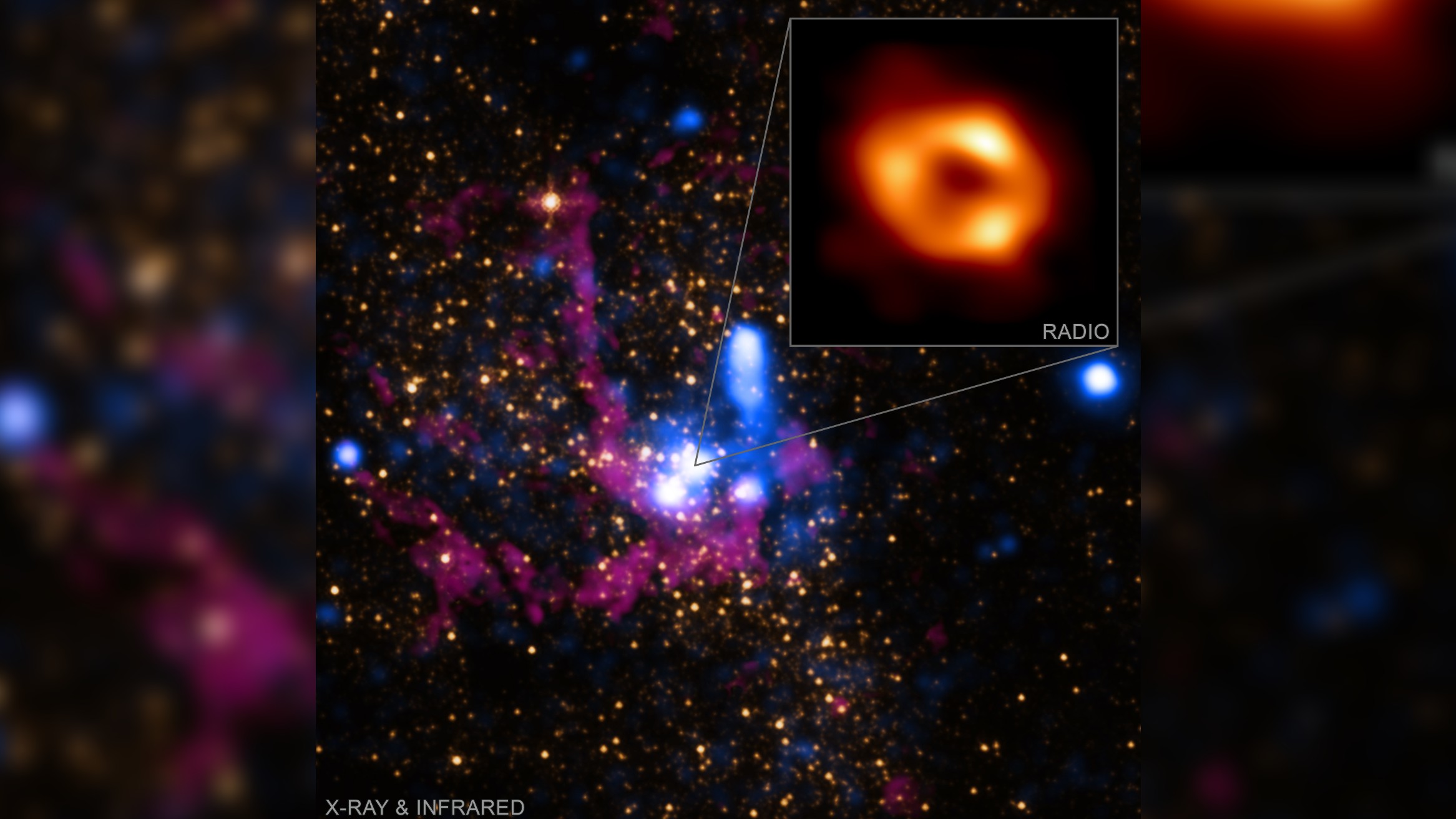Black holes and galaxies have a complicated relationship.
Astronomers think nearly every galaxy hosts a giant black hole in its core. And while those black holes truly are massive — weighing millions, or even billions, of solar masses — they are tiny compared with their home galaxies, reaching less than 1% of the mass of a typical galaxy and a volume a billion times smaller.
Despite the huge discrepancy, these massive black holes are capable of exerting an outsize influence, controlling the rate of star formation for billions of years.
So why is it that black holes and galaxies have such a seemingly unlikely relationship?
Related: How many black holes are there in the universe?
The cores of galaxies are their densest regions, crammed not just with stars, but also gas. At the center of most, if not all, galaxies sits a supermassive black hole. The smallest ones are a million times more massive than the sun; the largest top the charts at over a hundred billion times the mass of our home star.
Naturally, those black holes exert an enormous gravitational pull on their surroundings, and any gas or stars that wander too close find themselves trapped in a deadly embrace. As all that material crams into the space surrounding the black hole, it heats up, because that's what materials do when you compress them. Very quickly, the material flattens into a thin accretion disk that swirls around the black hole.

Tiny instabilities in the accretion disk cause magnetic-field lines to bunch up on themselves, folding over and over, thereby driving up the strength of the magnetic field in the disk. While most of the material around the black hole plunges below the event horizon, never to be seen in this universe again, the strong magnetic fields latch on to some of the material, forcing it to follow twisting paths around the black hole before blasting the material out of the poles.
The jets of superheated plasma race out at nearly the speed of light, puncturing through the core and, in some cases, extending for tens of thousands of light-years.
M-sigma: The strange relation between black holes and galaxies
It's this activity around the supermassive black hole that scientists believe is behind an intriguing relationship between black holes and their host galaxies. Known as the M-sigma relation, it's a connection between the mass of the supermassive black hole (M) and the velocity dispersion in the gas of the galactic core (denoted by the Greek letter sigma).
The velocity dispersion is a measure of the "jiggliness" of a clump of gas. Larger dispersions mean that pockets of gas have a broad range of velocities, while a small dispersion means that pockets of gas have roughly the same velocity. The M-sigma relation tells us that for a wide range of galaxies, the more massive the black hole is, the greater the velocity dispersion — in other words, the more activity taking place in the core.

The feeding of the black hole and the launching of its impressive jets make up only one side of the story, however. After the jets launch, they heat up the gas in the core. With so much energy, the gas has a difficult time making it down to the vicinity of the black hole — so the accretion disk thins out, and the jets power down. But after a long enough time, the gas cools off again and makes its way to the black hole's lair, before the cycle repeats.
This intimate connection between the black hole and its surroundings is called feedback, and it regulates both the growth of the black hole and the energy in the galaxy, establishing the M-sigma relation.
Keeping balance
This feedback cycle also governs something else that's critical to the evolution of galaxies: the rate of star formation.
When pockets of gas in a galaxy are relatively cool, they can reach the incredible densities needed to trigger the formation of stars. If the gas is too hot, star formation slows down. There are many sources of heat within a galaxy, like the energy released from supernovas, but perhaps the biggest players in the galactic scene are those same supermassive black holes.

The feedback from supermassive black holes regulates star formation throughout the entire galaxy. Without outflows from giant black holes, star formation would happen much faster, potentially even draining a galaxy of the reservoirs of gas needed to produce new stars. Without giant black holes, galaxies would live fast and die young, leaving behind populations of small, red, dim stars and no new star formation in the present era of the universe.
However, that delicate balance can go off-kilter. Sometimes, the outflows from black holes can grow too strong, not only heating the gas in a galaxy but removing it from the galaxy altogether. This doesn't just reduce star formation; it shuts it off completely. This kind of "quenching" can happen especially after major galactic merger events, when too much material falls into a central black hole too quickly.
The Milky Way has its own giant black hole, called Sagittarius A*. It's relatively quiet now, with its last outburst safely millions of years in the past. But while that black hole seems menacing, it's an essential part of regulating the evolution of every galaxy, keeping star formation at an even-tempered rate. Perhaps without it, the Milky Way might have run out of star-forming gas long ago, and the sun might not have ever appeared.
Learn more by listening to the "Ask a Spaceman" podcast, available on iTunes (opens in new tab) and askaspaceman.com. Ask your own question on Twitter using #AskASpaceman or by following Paul @PaulMattSutter and facebook.com/PaulMattSutter. Follow us on Twitter @Spacedotcom and on Facebook.
Post a Comment